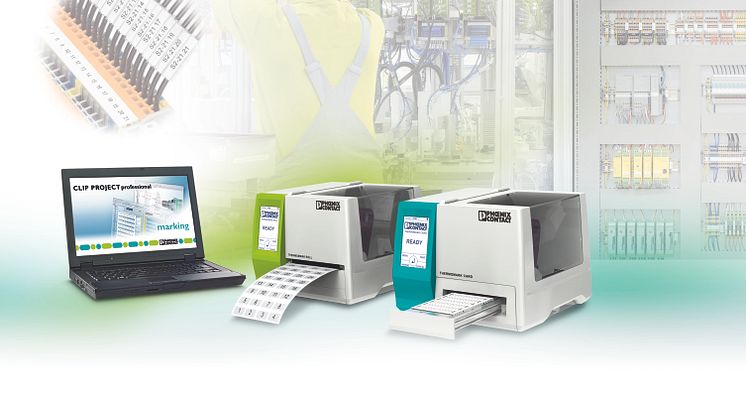
Press release -
Professional and Simple Marking: Cost-Saving Potential Using the Correct Printing System.
Planning and Engineering
Generally, CAE systems are used to plan and engineer electrical plants and systems. All of the marking-relevant data, such as identification information or the cross sections of conductors and cables, are saved there. The integration between EPLAN Electric P8, and software programs such as Clip Project from Phoenix Contact means that there is a seamless transfer of all relevant marking data. As part of the value-added chain, the program retrieves the information from EPLAN Electric P8 at the click of a mouse: information on terminal points, cables and conductors, as well as identification data from the circuit diagram. The complete ordering, parts, design, and assembly lists are generated in addition to a two-dimensional image of the terminal strip.
Selecting Marking Materials
When marking electrical components, a distinction is made between marking terminals, conductors/cables, and equipment. A clear print image ensures good readability of the information even where space is restricted.
To ensure a uniform standard of quality when marking various pieces of equipment and terminals, the range of marking materials should be tailored to components from various manufacturers. Before selecting the marking, several factors should be taken into consideration:
- What materials are permitted?
- What chemicals must the material be resistant to?
- What temperature range is required?
- Is approval such as UL or CSA required?
- What flammability class according to UL 94 does the material have to comply with?
The requirements placed on the material differ depending on the particular sector, for example, transportation, power technology, food industry, nuclear power plants, machinery, cabinet and plant building.
Selecting a Suitable Printing Technique
State-of-the-art marking offers many advantages: good permanent readability, an optically attractive image, as well as a high degree of resistance to mechanical and chemical effects. Various printing techniques fulfill these demands. For instance, a laser printer ensures that the marking has a high level of durability. However, this is infrequently used in cabinet building because of the high safety requirements and high investment costs.
Ink-based systems such as labeling plotters are more frequently used. In this case, a solvent-based ink is used, which hardens when the solvent vaporizes. The principle is simple, but has the disadvantage that the labeling pens simply dry out when the solvent escapes. Ink-based systems contain solvents that ensure that the printing ink has the required viscosity. As a result of vaporization, with or without applying heat, solvents such as alcohol, oils, or water are dissipated to the environment and the ink dye itself remains as a solid on the substrate. This procedure can barely be controlled, as vaporization depends on additional factors.
Ambient temperature, air humidity, and the time between the printing operations play a decisive role. Continually regulating the printing process costs a lot of time and also results in high costs in operation. Not only this, the dried out pens and print cartridges are damaging to the environment.
The “Bluemark” printer also uses ink jet technology. The system developed by Phoenix Contact does not use solvent-based ink, but rather a solvent-free labeling fluid. UV light, utilizing LED technology, is used to cure the fluid. As a consequence, the labeling is resistant to solvents, smearing, and scratches. Thus this printing system is designed for high labeling volumes.
Thermal Transfer Printer as Flexible Alternative
The thermal transfer printer is an alternative to solvent-based marking systems; this is a printing technique where there is direct contact with the marking material. A thermal printing head is the central element, which can be simply considered as a print head with a pin cushion. The distance between the heating elements (needles) defines the print resolution. Today, 300 dpi (dots per inch) is standard, and even font sizes of 0.5 mm are possible.
The heating elements are very quickly heated up and cooled down again. The ink is applied to the print medium where the heating element comes into contact with the ink ribbon: smear-proof, insensitive to alkalines and acids, as well as resistant to temperatures up to 150 °C.
The advantages of this system, which operates with a fixed ink color, are quite clear: low purchase costs, compact and mobile, always available.
Thermal transfer printing is used nowadays to print labels and shrink tubing. In this case, generally flat roll materials are processed. The flat material can be simply transported and processed in the printer.
The roll material is primary suitable for mass processing of marking materials. The roll material is not flexible enough for small series, because the roll has to be changed each time the size or type is changed. To also be able to use the advantages of thermal transfer printing for these types of applications, Phoenix Contact developed the “Thermomark card”, which processes two card formats:
- Material in the 75 x 120 mm format for marking materials with raised contour – for example to label terminals
- Flat material in the 115 x 165 mm format as punched version to mark conductors, cables, and equipment at a favorable price
Before starting, the material is placed in the adapter magazine. In just 8 seconds, a card with up to 120 markings is completely printed.
Conclusion
Professional marking systems for the industrial environment operate with quite different materials, which fulfill different requirements depending on the application. Software programs form the basis for simple and direct input or for user-friendly transfer of labeling data from a CAE system. In each case, software, printing system, and marking materials form a closed system, in which all of the parameters are harmonized and coordinated with one another. Users not only save time and money, they also profit over the long term from high-quality marking.
If you are interested in publishing this article, please contact Becky Smith: bsmith@phoenixcontact.com or telephone 0845 881 2222.
Related links
Topics
Categories
Phoenix Contact, founded over 80 years ago, is a leading manufacturer of electric connection and industrial automation technology. 11,000 employees, 47 own sales companies and 30 sales partner worldwide ensure customer proximity.
Our work is dedicated to the creation of progress with inspiring, innovative solutions and to a trusting partnership towards our customers and partners with common benefits.

